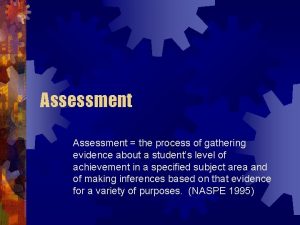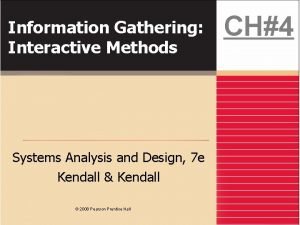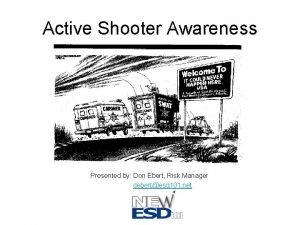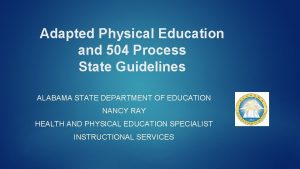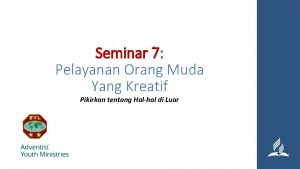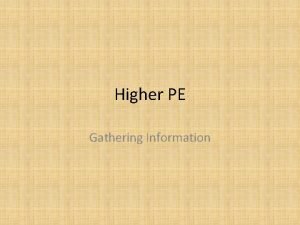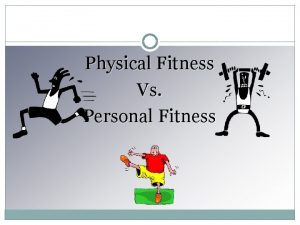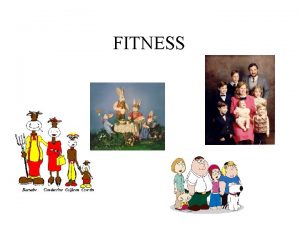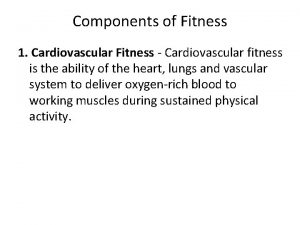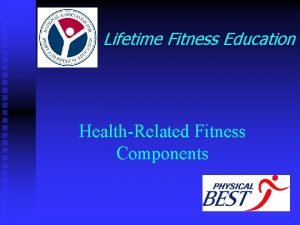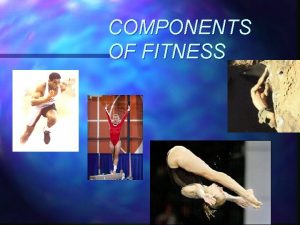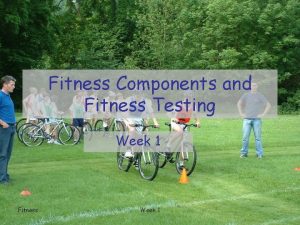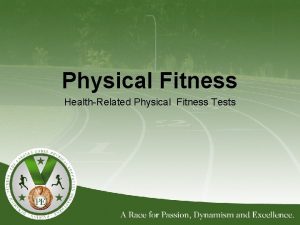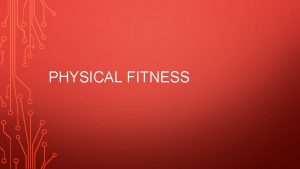National PE Cycle of Analysis Fitness Assessment Gathering
















- Slides: 16

National PE Cycle of Analysis

Fitness Assessment + Gathering Data • Why do we need to asses our fitness levels? ? *Strengths + Weeknesses -> Develop Performance Key Purposes… • Provides objective, accurate and reliable information about the performer in relation to the specific performance demands of the activity • Identifies areas of individual strengths and weaknesses • Provides a clear focus for planning a programme to improve performance related fitness • Provides a baseline or start point • Allows a process of monitoring and recording fitness development through comparison of the results of subsequent tests

• The process of fitness assessment allows the individual to progress by maximising strengths and addressing and therefore minimising weaknesses. • There are 2 main ways of assessing fitness the first is assessing fitness directly within the activity and the second is out with the activity through standardised fitness tests. Whichever methods are used there a few general principles, which should guide the process. The following should be considered before you begin to collect and record data about your fitness.

• • • What information is needed? What methods will be used to collect data? What will the data actually measure? How will the data be recorded? How will the data be used? In order for the data collected to be useful it must be Accurate; a true reflection of the performers ability Relevant; to the performer and the activity Valid; it actually measures what it sets out to Reliable; the assessment can be repeated consistently (test-retest method) • Objective; it is non biased • Contributes to informed decision making, and leads to action capable of improving performance • Enables comparison, by measuring initial baseline data with subsequent assessment • •

• There are 2 types of data that can be collected quantitative which is data that can be specifically measured e. g. objective data like the number of press ups in 30 seconds and qualitative which is data gathered form personal judgements, opinions and reflections e. g. subjective data like a coaches opinion of your performance.

Cycle of Anaylsis 1 4 2 3

Investigate Evaluate Analyse Develop

Cycle Of Analysis • Performance improvement programme • This is a process used to analysis performance with the overall aim of developing performance • By using the cycle of analysis you can continue to improve your performance at a steady pace and avoid ‘Learning Plateau’ – which is a stage of no apparent progress

Investigate • Explain how the performance was investigated/observed through the collection of information • This is when you collect information (DATA) about your own performance in an activity. • You can collect information on your performance by using a variety of methods – • Observation schedules • Video analysis • Reflections on your performance • Knowledge of results • Match analysis sheets

• You can collect information on your performance by using a variety of methods – Observation schedules Video analysis Reflections on your performance Knowledge of results Match analysis sheets

Analysis • Explain how key concept knowledge helped analyse your performance. • Looking at the data collected and identifying your strengths and weaknesses within your performance

Once sufficient data has been collected, the performer now has an opportunity to analyse the data and identify strengths and weaknesses in the performance. Feedback on the performance will be given from a variety of sources i. e. O. S. , videos, personal reflections and monitoring equipment. It is important that the feedback is given immediately in a positive manner; this will ensure that the performer remains motivated to continue with the analysis process. In addition, by comparing your performance with that of a model performer and model criteria you will also be able to identify your strengths and weaknesses. Model performers can be found from experienced members of the class, teachers or from video recordings of top class performers. They can be used in variety of ways. Model criteria, the technical criteria of specific aspects of performance, can be found from the teacher, model performer, books and or videos.

Develop • Devise and carry out a ‘programme of work’ to develop skill and improve performance. • This is the stage where you develop a programme of work or a fitness training programme that will allow you to work on and improve the weak areas of your performance

• Developing aspects of performance i. e. skills, strategies into a full sided competitive game should be done in a planned and systematic way, through simple straight forward stages. This allows the performer time and space to practice and develop their performance. The pressure on the performer is increase gradually from performing in a ‘no pressure’ out of context situation, to the final challenge of the pressure situation of a full even sided competitive game in basketball or singles game in badminton. Before embarking on a development programme, the performer should follow the Principles of Effective Practice to ensure that their programme is relevant and helpful.

Review/Evaluate • Reflect on the benefits of your ‘programme of work’ and discuss future development needs. • Review your performance by collecting further information (using the same methods as before) and comparing the results to see if any improvement has occurred.

HIGHER Moderation Activity - Basketball Criteria : Higher Grade A – Candidates should demonstrate a high level of control and fluency across a range of skills and techniques and apply these skills under pressure from opponents at a fast tempo Candidates should also demonstrate an understanding of situations in the game and how best to adapt / refine their play to overcome a given situation Grade B – Marks in the middle range should be awarded where the assessor judges that the candidates performance is above minimum competence but is not yet reflecting the full qualities associated with the Grade description for A Grade C – The candidate should select and combine skills to perform with control and fluency within contexts which offer a variety of options. Demonstrate a broad performance repertoire On the back of this sheet write a personal statement of your performance in basketball. You should mention Your individual skills Your performance in a team in terms of – your role – in offense and defence. Decision-making. Ability to adapt/react to what is happening in the game.
 Skill related fitness vs health related fitness
Skill related fitness vs health related fitness Methods of gathering data national 5 pe
Methods of gathering data national 5 pe Assessment is a process of gathering evidence of
Assessment is a process of gathering evidence of Fact finding in system analysis and design
Fact finding in system analysis and design Information gathering interview questions
Information gathering interview questions Cycle of analysis nat 5 pe
Cycle of analysis nat 5 pe Bath assessment active shooter
Bath assessment active shooter Alabama physical fitness assessment
Alabama physical fitness assessment Musculoskeletal fitness assessment
Musculoskeletal fitness assessment National unification and the national state
National unification and the national state Ux requirements gathering
Ux requirements gathering Quantitative research examples
Quantitative research examples Data gathering procedures example
Data gathering procedures example Youth gathering theme
Youth gathering theme Apa itu data requirement gathering
Apa itu data requirement gathering News gathering
News gathering Data warehouse requirements gathering
Data warehouse requirements gathering


